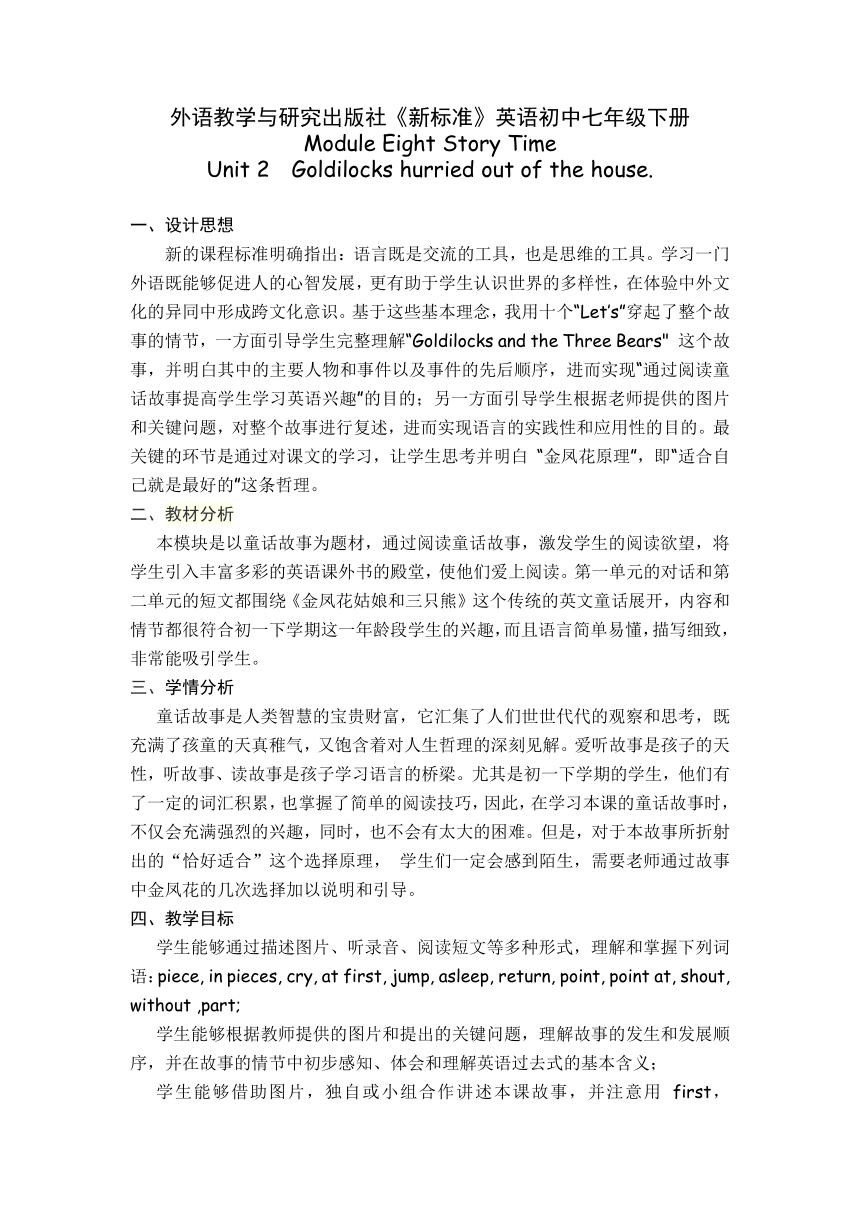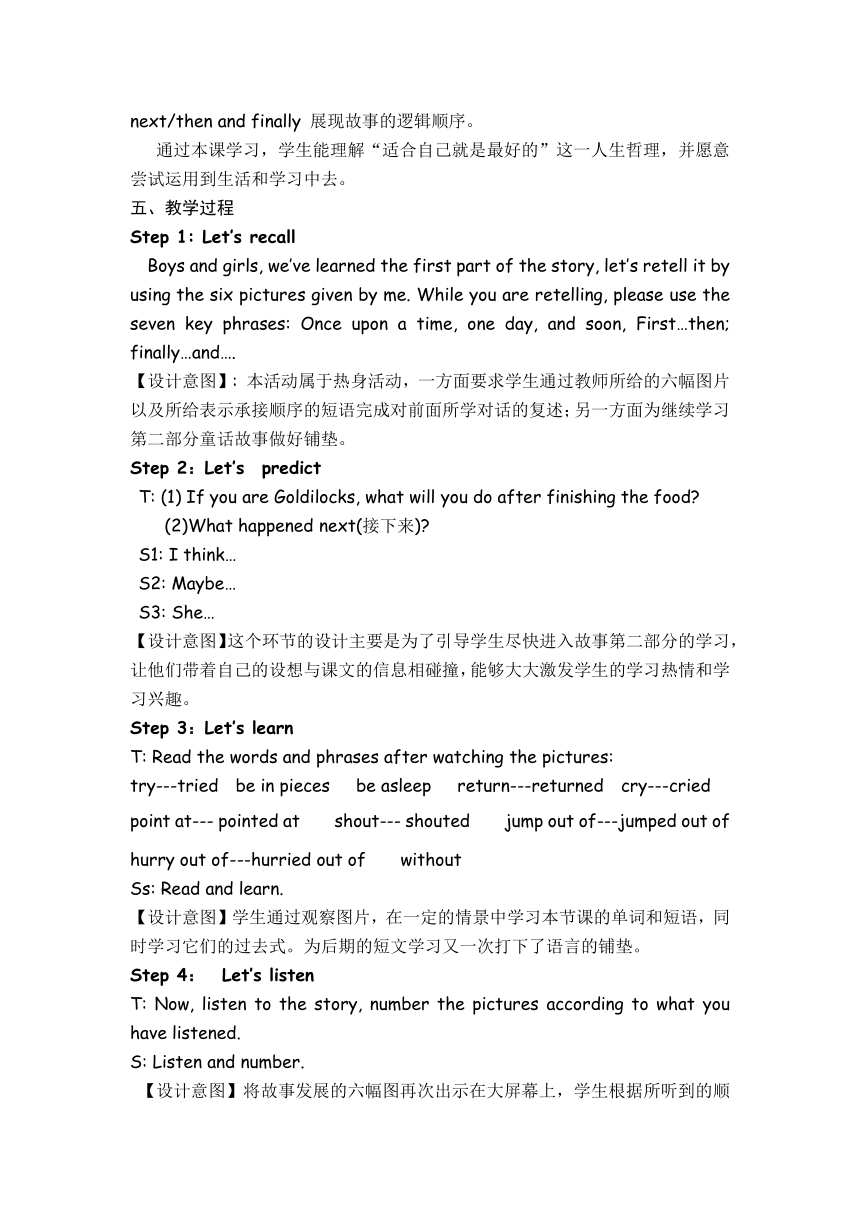Module 8 Unit 2 Goldilocks hurried out of the house. 教学设计
文档属性
| 名称 | Module 8 Unit 2 Goldilocks hurried out of the house. 教学设计 |  | |
| 格式 | zip | ||
| 文件大小 | 19.3KB | ||
| 资源类型 | 教案 | ||
| 版本资源 | 外研版 | ||
| 科目 | 英语 | ||
| 更新时间 | 2022-04-07 17:31:20 | ||
图片预览


文档简介
外语教学与研究出版社《新标准》英语初中七年级下册
Module Eight Story Time
Unit 2 Goldilocks hurried out of the house.
设计思想
新的课程标准明确指出:语言既是交流的工具,也是思维的工具。学习一门外语既能够促进人的心智发展,更有助于学生认识世界的多样性,在体验中外文化的异同中形成跨文化意识。基于这些基本理念,我用十个“Let’s”穿起了整个故事的情节,一方面引导学生完整理解“Goldilocks and the Three Bears" 这个故事,并明白其中的主要人物和事件以及事件的先后顺序,进而实现“通过阅读童话故事提高学生学习英语兴趣”的目的;另一方面引导学生根据老师提供的图片和关键问题,对整个故事进行复述,进而实现语言的实践性和应用性的目的。最关键的环节是通过对课文的学习,让学生思考并明白 “金凤花原理”,即“适合自己就是最好的”这条哲理。
教材分析
本模块是以童话故事为题材,通过阅读童话故事,激发学生的阅读欲望,将学生引入丰富多彩的英语课外书的殿堂,使他们爱上阅读。第一单元的对话和第二单元的短文都围绕《金凤花姑娘和三只熊》这个传统的英文童话展开,内容和情节都很符合初一下学期这一年龄段学生的兴趣,而且语言简单易懂,描写细致,非常能吸引学生。
学情分析
童话故事是人类智慧的宝贵财富,它汇集了人们世世代代的观察和思考,既充满了孩童的天真稚气,又饱含着对人生哲理的深刻见解。爱听故事是孩子的天性,听故事、读故事是孩子学习语言的桥梁。尤其是初一下学期的学生,他们有了一定的词汇积累,也掌握了简单的阅读技巧,因此,在学习本课的童话故事时,不仅会充满强烈的兴趣,同时,也不会有太大的困难。但是,对于本故事所折射出的“恰好适合”这个选择原理, 学生们一定会感到陌生,需要老师通过故事中金凤花的几次选择加以说明和引导。
四、教学目标
学生能够通过描述图片、听录音、阅读短文等多种形式,理解和掌握下列词语:piece, in pieces, cry, at first, jump, asleep, return, point, point at, shout, without ,part;
学生能够根据教师提供的图片和提出的关键问题,理解故事的发生和发展顺序,并在故事的情节中初步感知、体会和理解英语过去式的基本含义;
学生能够借助图片,独自或小组合作讲述本课故事,并注意用 first, next/then and finally 展现故事的逻辑顺序。
通过本课学习,学生能理解“适合自己就是最好的”这一人生哲理,并愿意尝试运用到生活和学习中去。
五、教学过程
Step 1: Let’s recall
Boys and girls, we’ve learned the first part of the story, let’s retell it by using the six pictures given by me. While you are retelling, please use the seven key phrases: Once upon a time, one day, and soon, First…then; finally…and….
【设计意图】: 本活动属于热身活动,一方面要求学生通过教师所给的六幅图片以及所给表示承接顺序的短语完成对前面所学对话的复述;另一方面为继续学习第二部分童话故事做好铺垫。
Step 2:Let’s predict
T: (1) If you are Goldilocks, what will you do after finishing the food
(2)What happened next(接下来)
S1: I think…
S2: Maybe…
S3: She…
【设计意图】这个环节的设计主要是为了引导学生尽快进入故事第二部分的学习,让他们带着自己的设想与课文的信息相碰撞,能够大大激发学生的学习热情和学习兴趣。
Step 3:Let’s learn
T: Read the words and phrases after watching the pictures:
try---tried be in pieces be asleep return---returned cry---cried
point at--- pointed at shout--- shouted jump out of---jumped out of
hurry out of---hurried out of without
Ss: Read and learn.
【设计意图】学生通过观察图片,在一定的情景中学习本节课的单词和短语,同时学习它们的过去式。为后期的短文学习又一次打下了语言的铺垫。
Step 4: Let’s listen
T: Now, listen to the story, number the pictures according to what you have listened.
S: Listen and number.
【设计意图】将故事发展的六幅图再次出示在大屏幕上,学生根据所听到的顺序将它们排序,通过听第一次感知短文所表达的完整故事。
Step 5 Let’s read the passage
Read for the first time:
T: Please read quickly and check the right information.
1. Goldilocks liked the big chair.
2. Goldilocks liked the small bed.
3. Baby Bear looked in the bedroom.
4. The Three Bears were happy to see Goldilocks.
5. Goldilocks didn’t like the Three Bears.
S: Read and check.
Read for the second time:
T: Now read the passage quickly again and answer the following questions.
1.How many chairs were there
2.What did she think of the big chair
3.What happened to the smallest chair
4.Which bed did she like
5.Was she very tired How do you know
S: Read and answer.
Read for the third time:
T:人生在于不断地去发现(To discover it),去尝试(to try it),并不断地为我们的尝试付出努力和代价(To pay for it).So,Please read the passage again and find how many main paragraphs are there in it
S: Read and answer the following three parts of questions.
Part One :
1.What did Goldilocks discover
2.What did she try
3.What happened
Part Two:
1.What did the Baby Bear discover
2. How did he feel
Part Three:
What happened to Goldilocks finally
【设计意图】这个环节我设计了三次对课文的阅读,按照由易到难的顺序分别设计了三组问题,引导学生逐渐加深对短文的理解,由浅层的判断,到中等难易程度的回答问题,要求学生既有对文章的理解又有语言的组织,最后到对篇章层次的整体划分,对学生的要求在逐渐加大。
Step 6 Let’s retell the passage.
T: Now, let’s retell the whole passage by using what I ‘ve given you.
Part One: Something about Goldilocks——第1/2自然段
1.What did Goldilocks want to do Why
2.What did she try How were they
3.What happened to the small chair
4.How many beds were there in the bedroom How was the small one
5. What did she do
Part Two: Something about the Three Bears——第3/4自然段
After the Three Bears returned——
First——
(1)What did they do
(2)What did the Baby Bear do How was he Why
Next——
(1)What did the Bears do
(2)What did the Baby Bear do then
Part Three: The result of the story——第5自然段
Finally——
(1)What did Goldilocks do
(2)Where were the Three Bears
(3)So, what did Goldilocks do
【设计意图】 通过三部分问题的牵引,引导学生对故事的第二部分进行复述,实现提高语言综合运用能力的目的。
Step 7: Let’s tell the story
T: Now, we’ve finished learning the whole story, now let’s tell it by using the given pictures. Try to use “first, next/then, finally” to help you
Ss: Try to tell in groups.
SS:Try to tell the story individually.
S1—3:Show their story.
【设计意图】这个环节旨在给学生一个完整的故事情节,通过图片的引领,加上教师提供的关键词,即表示故事发生、发展先后顺序的承接词,让学生尝试讲完整的故事。先是以小组展示,后是个体展示。
Step 8: Let’s imagine
T: Boys and girls, you’ve known what happened to Goldilocks from the story, but who knows what will happen next Now let’s use our imagination, and think what will happen next
Ss: Have a discussion and then show their opinion.
【设计意图】这个环节旨在让学生充分发挥想象力,给故事提供一个更为完整的结尾。
Step 9: Let’s enjoy
T: Show some beautiful pictures of goldilocks.
Ss: Enjoy them.
【设计意图】学生从枯燥的语言中解放出来,欣赏一下goldilocks 这种漂亮的花,进而打开学生的思维,为下一个环节做好铺垫。
Step 10: Let’s think
T: Goldilocks chose the small bow, the small bed and the small chair though the others are bigger, why
Ss: Think… and try to show their ideas.
【设计意图】再次从课文的故事出发,引导学生从另外一个角度进行思考问题,进而完成对金凤花原理的理解——适合就是最好的。真正拓宽学生的视野,提高学生的人文素养。
六、作业设计
A. 模仿点读笔的语音语调,带有情感朗读课文;
B. 小组模仿表演本课故事;
C. 独自有感情地讲述本课故事;
D 根据想象,续编故事。
请同学们任选以上两道作业。
七、设计反思
本节课我通过听说读三种方式,使学生完成对故事的理解,各项指标都完成得很好,尤其是读的环节非常到位,进而学生在后来的语言输出环节即口头复述很顺畅。简单的故事中往往蕴含着非常深刻的道理,本节课中我深入挖掘了童话故事背后的文化信息,即金凤花原理,因而学生学完本节课后,在思维方式、在生活中他们都会有一定的思考和变化,这应该是他们一生的财富!
Module Eight Story Time
Unit 2 Goldilocks hurried out of the house.
设计思想
新的课程标准明确指出:语言既是交流的工具,也是思维的工具。学习一门外语既能够促进人的心智发展,更有助于学生认识世界的多样性,在体验中外文化的异同中形成跨文化意识。基于这些基本理念,我用十个“Let’s”穿起了整个故事的情节,一方面引导学生完整理解“Goldilocks and the Three Bears" 这个故事,并明白其中的主要人物和事件以及事件的先后顺序,进而实现“通过阅读童话故事提高学生学习英语兴趣”的目的;另一方面引导学生根据老师提供的图片和关键问题,对整个故事进行复述,进而实现语言的实践性和应用性的目的。最关键的环节是通过对课文的学习,让学生思考并明白 “金凤花原理”,即“适合自己就是最好的”这条哲理。
教材分析
本模块是以童话故事为题材,通过阅读童话故事,激发学生的阅读欲望,将学生引入丰富多彩的英语课外书的殿堂,使他们爱上阅读。第一单元的对话和第二单元的短文都围绕《金凤花姑娘和三只熊》这个传统的英文童话展开,内容和情节都很符合初一下学期这一年龄段学生的兴趣,而且语言简单易懂,描写细致,非常能吸引学生。
学情分析
童话故事是人类智慧的宝贵财富,它汇集了人们世世代代的观察和思考,既充满了孩童的天真稚气,又饱含着对人生哲理的深刻见解。爱听故事是孩子的天性,听故事、读故事是孩子学习语言的桥梁。尤其是初一下学期的学生,他们有了一定的词汇积累,也掌握了简单的阅读技巧,因此,在学习本课的童话故事时,不仅会充满强烈的兴趣,同时,也不会有太大的困难。但是,对于本故事所折射出的“恰好适合”这个选择原理, 学生们一定会感到陌生,需要老师通过故事中金凤花的几次选择加以说明和引导。
四、教学目标
学生能够通过描述图片、听录音、阅读短文等多种形式,理解和掌握下列词语:piece, in pieces, cry, at first, jump, asleep, return, point, point at, shout, without ,part;
学生能够根据教师提供的图片和提出的关键问题,理解故事的发生和发展顺序,并在故事的情节中初步感知、体会和理解英语过去式的基本含义;
学生能够借助图片,独自或小组合作讲述本课故事,并注意用 first, next/then and finally 展现故事的逻辑顺序。
通过本课学习,学生能理解“适合自己就是最好的”这一人生哲理,并愿意尝试运用到生活和学习中去。
五、教学过程
Step 1: Let’s recall
Boys and girls, we’ve learned the first part of the story, let’s retell it by using the six pictures given by me. While you are retelling, please use the seven key phrases: Once upon a time, one day, and soon, First…then; finally…and….
【设计意图】: 本活动属于热身活动,一方面要求学生通过教师所给的六幅图片以及所给表示承接顺序的短语完成对前面所学对话的复述;另一方面为继续学习第二部分童话故事做好铺垫。
Step 2:Let’s predict
T: (1) If you are Goldilocks, what will you do after finishing the food
(2)What happened next(接下来)
S1: I think…
S2: Maybe…
S3: She…
【设计意图】这个环节的设计主要是为了引导学生尽快进入故事第二部分的学习,让他们带着自己的设想与课文的信息相碰撞,能够大大激发学生的学习热情和学习兴趣。
Step 3:Let’s learn
T: Read the words and phrases after watching the pictures:
try---tried be in pieces be asleep return---returned cry---cried
point at--- pointed at shout--- shouted jump out of---jumped out of
hurry out of---hurried out of without
Ss: Read and learn.
【设计意图】学生通过观察图片,在一定的情景中学习本节课的单词和短语,同时学习它们的过去式。为后期的短文学习又一次打下了语言的铺垫。
Step 4: Let’s listen
T: Now, listen to the story, number the pictures according to what you have listened.
S: Listen and number.
【设计意图】将故事发展的六幅图再次出示在大屏幕上,学生根据所听到的顺序将它们排序,通过听第一次感知短文所表达的完整故事。
Step 5 Let’s read the passage
Read for the first time:
T: Please read quickly and check the right information.
1. Goldilocks liked the big chair.
2. Goldilocks liked the small bed.
3. Baby Bear looked in the bedroom.
4. The Three Bears were happy to see Goldilocks.
5. Goldilocks didn’t like the Three Bears.
S: Read and check.
Read for the second time:
T: Now read the passage quickly again and answer the following questions.
1.How many chairs were there
2.What did she think of the big chair
3.What happened to the smallest chair
4.Which bed did she like
5.Was she very tired How do you know
S: Read and answer.
Read for the third time:
T:人生在于不断地去发现(To discover it),去尝试(to try it),并不断地为我们的尝试付出努力和代价(To pay for it).So,Please read the passage again and find how many main paragraphs are there in it
S: Read and answer the following three parts of questions.
Part One :
1.What did Goldilocks discover
2.What did she try
3.What happened
Part Two:
1.What did the Baby Bear discover
2. How did he feel
Part Three:
What happened to Goldilocks finally
【设计意图】这个环节我设计了三次对课文的阅读,按照由易到难的顺序分别设计了三组问题,引导学生逐渐加深对短文的理解,由浅层的判断,到中等难易程度的回答问题,要求学生既有对文章的理解又有语言的组织,最后到对篇章层次的整体划分,对学生的要求在逐渐加大。
Step 6 Let’s retell the passage.
T: Now, let’s retell the whole passage by using what I ‘ve given you.
Part One: Something about Goldilocks——第1/2自然段
1.What did Goldilocks want to do Why
2.What did she try How were they
3.What happened to the small chair
4.How many beds were there in the bedroom How was the small one
5. What did she do
Part Two: Something about the Three Bears——第3/4自然段
After the Three Bears returned——
First——
(1)What did they do
(2)What did the Baby Bear do How was he Why
Next——
(1)What did the Bears do
(2)What did the Baby Bear do then
Part Three: The result of the story——第5自然段
Finally——
(1)What did Goldilocks do
(2)Where were the Three Bears
(3)So, what did Goldilocks do
【设计意图】 通过三部分问题的牵引,引导学生对故事的第二部分进行复述,实现提高语言综合运用能力的目的。
Step 7: Let’s tell the story
T: Now, we’ve finished learning the whole story, now let’s tell it by using the given pictures. Try to use “first, next/then, finally” to help you
Ss: Try to tell in groups.
SS:Try to tell the story individually.
S1—3:Show their story.
【设计意图】这个环节旨在给学生一个完整的故事情节,通过图片的引领,加上教师提供的关键词,即表示故事发生、发展先后顺序的承接词,让学生尝试讲完整的故事。先是以小组展示,后是个体展示。
Step 8: Let’s imagine
T: Boys and girls, you’ve known what happened to Goldilocks from the story, but who knows what will happen next Now let’s use our imagination, and think what will happen next
Ss: Have a discussion and then show their opinion.
【设计意图】这个环节旨在让学生充分发挥想象力,给故事提供一个更为完整的结尾。
Step 9: Let’s enjoy
T: Show some beautiful pictures of goldilocks.
Ss: Enjoy them.
【设计意图】学生从枯燥的语言中解放出来,欣赏一下goldilocks 这种漂亮的花,进而打开学生的思维,为下一个环节做好铺垫。
Step 10: Let’s think
T: Goldilocks chose the small bow, the small bed and the small chair though the others are bigger, why
Ss: Think… and try to show their ideas.
【设计意图】再次从课文的故事出发,引导学生从另外一个角度进行思考问题,进而完成对金凤花原理的理解——适合就是最好的。真正拓宽学生的视野,提高学生的人文素养。
六、作业设计
A. 模仿点读笔的语音语调,带有情感朗读课文;
B. 小组模仿表演本课故事;
C. 独自有感情地讲述本课故事;
D 根据想象,续编故事。
请同学们任选以上两道作业。
七、设计反思
本节课我通过听说读三种方式,使学生完成对故事的理解,各项指标都完成得很好,尤其是读的环节非常到位,进而学生在后来的语言输出环节即口头复述很顺畅。简单的故事中往往蕴含着非常深刻的道理,本节课中我深入挖掘了童话故事背后的文化信息,即金凤花原理,因而学生学完本节课后,在思维方式、在生活中他们都会有一定的思考和变化,这应该是他们一生的财富!
同课章节目录
- Module 1 Lost and found
- Unit 1 Whose bag is this?
- Unit 2 Are they yours?
- Unit 3 Language in use
- Module 2 What can you do ?
- Unit 1 I can play the piano
- Unit 2 I can run really fast
- Unit 3 Language in use
- Module 3 Making plans
- Unit 1 What are you going to do at the weekends?
- Unit 2 We're going to cheer the players.
- Unit 3 Language in use
- Module 4 Life in the future
- Unit 1 Everyone will study at home
- Unit 2 Every family will have a small plane.
- Unit 3 Language in use
- Module 5 Shopping
- Unit 1 What can I do for you?
- Unit 2 You can buy everything on the Internet
- Unit 3 Language in use
- Module 6 Around town
- Unit 1 Could you tell me how to get to the Nationa
- Unit 2 The London Eye is on your right.
- Unit 3 Language in use
- Revision module A
- Module 7 My past life
- Unit 1 I was born in a small village.
- Unit 2 I was born in Quincy.
- Unit 3 Language in use
- Module 8 Story time
- Unit 1 Once upon a time….
- Unit 2 Goldilocks hurried out of the house.
- Unit 3 Language in use
- Module 9 Life history
- Unit 1 He left school and began work at the age of
- Unit 2 He decided to be an actor.
- Unit 3 Language in use
- Module 10 A holiday journey
- Unit 1 What did you do?
- Unit 2 This morning we took a walk.
- Unit 3 Language in use
- Module 11 Body language
- Unit 1 They touch noses!
- Unit 2 Here are some ways to welcome them.
- Unit 3 Language in use
- Module 12 Western music
- Unit 1 It's so beautiful!
- Unit 2 Vienna is the centre of European classical
- Unit 3 Language in use
- Revision module B
